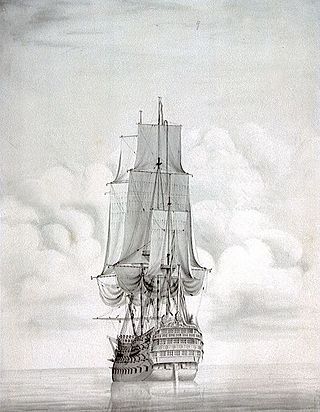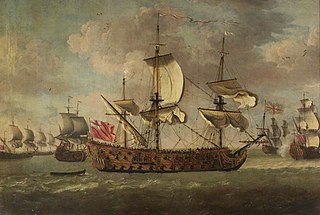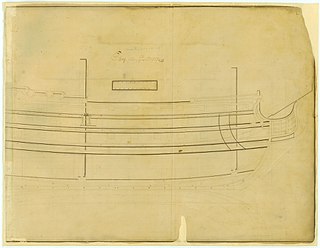
HMS Vanguard was a 90-gun second-rate ship of the line of the Royal Navy, built at Portsmouth Dockyard and launched in 1678.

HMS Royal Oak was a 74-gun third-rate ship of the line of the Royal Navy, built by Jonas Shish at Deptford and launched in 1674. She was one of only three Royal Navy ships to be equipped with the Rupertinoe naval gun. Life aboard her when cruising in the Mediterranean Sea in 1679 is described in the diary of Henry Teonge.

HMS Duke was a 90-gun second-rate ship of the line of the Royal Navy, launched on 13 June 1682 at Woolwich Dockyard.

HMS Royal Sovereign was a 100-gun first rate ship of the line of the Royal Navy, built at Woolwich Dockyard and launched in July 1701. She had been built using some of the salvageable timbers from the previous Royal Sovereign, which had been destroyed by fire in 1697.
HMS Greenwich was a 54-gun fourth-rate ship of the line of the Royal Navy, built by Christopher Pett at Woolwich Dockyard and launched in 1666.

HMS Falkland was a 50-gun fourth-rate ship of the line of the Royal Navy, built by Holland of New Castle, New Hampshire, and purchased by the navy in 1696.

HMS St Michael was a 90-gun second rate ship of the line of the Royal Navy, built by John Tippetts of Portsmouth Dockyard and launched in 1669.

HMS Swiftsure was a 70-gun third-rate ship of the line of the Royal Navy, built by Sir Anthony Deane at Harwich, and launched in 1673. By 1685 she had been reduced to a 66-gun ship.

President was a 38-gun fourth rate frigate of the Royal Navy, originally built for the navy of the Commonwealth of England by Peter Pett I at Deptford Dockyard, and launched in 1650.
HMS Albemarle was a 90-gun second rate ship of the line of the Royal Navy, launched on 29 October 1680 at Harwich.

HMS Ossory was a 90-gun second rate ship of the line of the Royal Navy, launched on 24 August 1682 at Portsmouth Dockyard. She was renamed HMS Prince in 1705.

HMS Humber was an 80-gun third rate ship of the line of the Royal Navy, launched at Hull on 30 March 1693.

HMS Newark was an 80-gun third rate ship of the line of the Royal Navy, launched at Hull on 3 June 1695.

HMS Canterbury was a 60-gun fourth-rate ship of the line of the Royal Navy, launched at Deptford on 18 December 1693.

HMS Ipswich was a 70-gun third-rate ship of the line of the Royal Navy, launched at Harwich on 19 April 1694.

HMS Mary was a 60-gun fourth rate ship of the line of the Royal Navy, built at Chatham Dockyard and launched on 12 May 1704.

HMS Grafton was a 70-gun third rate ship of the line of the Royal Navy. She was built by Swallow and Fowler, of Limehouse, London, to the dimensions of the 1706 Establishment, and was launched on 9 August 1709.

HMS St Albans was a 50-gun fourth rate ship of the line of the Royal Navy, built at Rotherhithe and launched on 10 December 1706.

HMS Plymouth was a 60-gun fourth rate ship of the line of the Royal Navy, built at Devonport Dockyard to the 1706 Establishment of dimensions, and launched on 25 May 1708.

HMS Colchester was a 50-gun fourth rate ship of the line of the Royal Navy, built at Southampton according to the dimensions laid down in the 1741 proposals of the 1719 Establishment, and launched on 20 September 1745. She was ordered as a replacement for the previous HMS Colchester, which had been wrecked just two months after being launched.

















